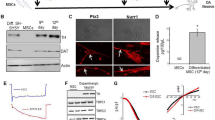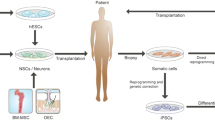Abstract
Parkinson’s disease (PD) is one of the most common neural degenerative disease, affecting millions of people globally. Great progress has been made in the PD treatment, and one of the most promising one is the stem cell-based therapy. Thus, studies on the differentiation of neural stem cells (NSCs) are important to the advancement in PD therapy. In this study, we used the rat NSCs to elucidate the role of Lithium in the proliferation and differentiation of NSCs by immunostaining against Ki67 and BrdU analysis as well as immunostaining against specific neuronal markers. We concluded that lithium chloride (LiCl) treatment could enhance the proliferation in NSCs and promote the dopaminergic neuronal differentiation of NSCs in vitro. This process was potentially mediated by Wnt signaling pathway. Using the 6-OHDA-induced PD models, we provided evidence to show that LiCl had the capacity to enhance the proliferation in NSCs and differentiation towards dopaminergic neurons in vivo. The beneficial effect of LiCl treatment was further validated by the fact that the motor function as well as learning and memory was improved in the PD models through Rotarod test and Morris water maze analysis. The learning and memory improvement was further supported by the increase in dendrite spine density in PD models receiving LiCl-treated NSCs. Through this study, we concluded that Lithium plays an important role in promoting NSCs’ neuronal differentiation in vitro and improving the symptoms of PD models in vivo. It is of great significance that this work showed the potential application of Lithium in the PD therapy in the future.





Similar content being viewed by others
References
Cabrera O, Dougherty J, Singh S, Swiney BS, Farber NB, Noguchi KK (2014) Lithium protects against glucocorticoid induced neural progenitor cell apoptosis in the developing cerebellum. Brain Res 1545:54–63
Ding Y, Zhang Z, Ma J, Xia H, Wang Y, Liu Y, Ma Q, Sun T, Liu J (2016) Directed differentiation of postnatal hippocampal neural stem cells generates nuclear receptor related1 protein and tyrosine hydroxylaseexpressing cells. Mol Med Rep 14:1993–1999
Dong BT, Tu GJ, Han YX, Chen Y (2015) Lithium enhanced cell proliferation and differentiation of mesenchymal stem cells to neural cells in rat spinal cord. Int J Clin Exp Pathol 8:2473–2483
Ferensztajn-Rochowiak E, Rybakowski JK (2016) The effect of lithium on hematopoietic, mesenchymal and neural stem cells. Pharmacol Rep 68:224–230
Giordano S, Darley-Usmar V, Zhang JH (2014) Autophagy as an essential cellular antioxidant pathway in neurodegenerative disease. Redox Biol 2:82–90
Hou L, Xiong N, Liu L, Huang J, Han C, Zhang G, Li J, Xu X, Lin Z, Wang T (2015) Lithium protects dopaminergic cells from rotenone toxicity via autophagy enhancement. BMC Neurosci 16:82
Huo K, Sun Y, Li H, Du X, Wang X, Karlsson N, Zhu C, Blomgren K (2012) Lithium reduced neural progenitor apoptosis in the hippocampus and ameliorated functional deficits after irradiation to the immature mouse brain. Mol Cell Neurosci 51:32–42
Keranen T, Jarvinen H, Laitinen K (2015) Medication information needs of patients with Parkinson’s disease. Mov Disord 30:S96–S96
Lee JE, Lim MS, Park JH, Park CH, Koh HC (2016a) PTEN promotes dopaminergic neuronal differentiation through regulation of ERK-dependent inhibition of S6K signaling in human neural stem cells. Stem Cells Transl Med 5:1319–1329
Lee JE, Lim MS, Park JH, Park CH, Koh HC (2016b) S6K promotes dopaminergic neuronal differentiation through PI3K/Akt/mTOR-dependent signaling pathways in human neural stem cells. Mol Neurobiol 53:3771–3782
Lim DA, Alvarez-Buylla A (2014) Adult neural stem cells stake their ground. Trends Neurosci 37:563–571
Liu B, Yu HMI, Hsu W (2007) Craniosynostosis caused by Axin2 deficiency is mediated through distinct functions of beta-catenin in proliferation and differentiation. Dev Biol 301:298–308
Meffre D, Massaad C, Grenier J (2015) Lithium chloride stimulates PLP and MBP expression in oligodendrocytes via Wnt/beta-catenin and Akt/CREB pathways. Neuroscience 284:962–971
Ming GL, Song H (2011) Adult neurogenesis in the mammalian brain: significant answers and significant questions. Neuron 70:687–702
Molyneaux KA, Zinszner H, Kunwar PS, Schaible K, Stebler J, Sunshine MJ, O’Brien W, Raz E, Littman D, Wylie C et al (2003) The chemokine SDF1/CXCL12 and its receptor CXCR4 regulate mouse germ cell migration and survival. Development 130:4279–4286
Moore DJ, West AB, Dawson VL, Dawson TM (2005) Molecular pathophysiology of Parkinson’s disease. Annu Rev Neurosci 28:57–87
Motoi Y, Shimada K, Ishiguro K, Hattori N (2014) Lithium and autophagy. ACS Chem Neurosci 5:434–442
Quan FS, Chen J, Zhong Y, Ren WZ (2016) Comparative effect of immature neuronal or glial cell transplantation on motor functional recovery following experimental traumatic brain injury in rats. Exp Ther Med 12:1671–1680
Shan T, Zhou C, Yang R, Yan F, Zhang P, Fu Y, Jiang H (2015) Lithium chloride promotes the odontoblast differentiation of hair follicle neural crest cells by activating Wnt/beta-catenin signaling. Cell Biol Int 39:35–43
Silva AK, Yi H, Hayes SH, Seigel GM, Hackam AS (2010) Lithium chloride regulates the proliferation of stem-like cells in retinoblastoma cell lines: a potential role for the canonical Wnt signaling pathway. Mol Vis 16:36–45
Tafreshi AP, Sylvain A, Sun GZ, Herszfeld D, Schulze K, Bernard CCA (2015) Lithium chloride improves the efficiency of induced pluripotent stem cell-derived neurospheres. Biol Chem 396:923–928
Tang L, Chen Y, Pei F, Zhang H (2015) Lithium chloride modulates adipogenesis and osteogenesis of human bone marrow-derived mesenchymal stem cells. Cell Physiol Biochem 37:143–152
Vorhees CV, Williams MT (2006) Morris water maze: procedures for assessing spatial and related forms of learning and memory. Nat Protoc 1:848–858
Yazlovitskaya EM, Edwards E, Thotala D, Fu A, Osusky KL, Whetsell WO Jr, Boone B, Shinohara ET, Hallahan DE (2006) Lithium treatment prevents neurocognitive deficit resulting from cranial irradiation. Cancer Res 66:11179–11186
Yu YQ, Gu ST, Huang H, Wen TQ (2007) Combination of bFGF, heparin and laminin induce the generation of dopaminergic neurons from rat neural stem cells both in vitro and in vivo. J Neurol Sci 255:81–86
Zanni G, Di Martino E, Omelyanenko A, Andang M, Delle U, Elmroth K, Blomgren K (2015) Lithium increases proliferation of hippocampal neural stem/progenitor cells and rescues irradiation-induced cell cycle arrest in vitro. Oncotarget 6:37083–37097
Zhu Z, Yin J, Guan J, Hu B, Niu X, Jin D, Wang Y, Zhang C (2014) Lithium stimulates human bone marrow derived mesenchymal stem cell proliferation through GSK-3beta-dependent beta-catenin/Wnt pathway activation. FEBS J 281:5371–5389
Zhu B, Caldwell M, Song B (2016) Development of stem cell-based therapies for Parkinson’s disease. Int J Neurosci 126:955–962
Author information
Authors and Affiliations
Corresponding author
Ethics declarations
Conflict of interest
We declared that there is no conflict of interest.
Rights and permissions
About this article
Cite this article
Qi, L., Tang, Y., He, W. et al. Lithium chloride promotes neuronal differentiation of rat neural stem cells and enhances neural regeneration in Parkinson’s disease model. Cytotechnology 69, 277–287 (2017). https://doi.org/10.1007/s10616-016-0056-1
Received:
Accepted:
Published:
Issue Date:
DOI: https://doi.org/10.1007/s10616-016-0056-1




